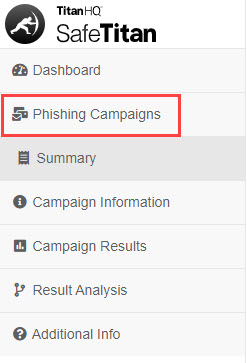Review Phishing Campaign
After you've created and published your first phishing campaign, follow these steps to ensure you received the mock phishing email and to view the campaign in the Phishing Campaigns List.
Check your emails to verify that you have received your first mock phishing email in your email inbox. If you did not receive it, or you found it in your Spam or Junk folder, refer to Add SafeTitan Mail Server to Allow List.
To test your campaign:
Open your email inbox.
Open and read the safe email.
Open the embedded link or attachment.
Go to Phishing Manager to view your campaign and its status. This is the screen where all created campaigns are listed and from where you can manage campaigns and view their details.
Beside your campaign, select View under the Actions column, where the following information is available:
Note
When you select View, the left navigation menu is condensed. As you navigate through the menu items available, you can return to the Phishing Manager menu by selecting Phishing Campaigns.

Summary: In this section, you can see the campaign name, its publication status, the dates related to its start, end and completion. Note that none of the fields are editable in this section.
Info: This section contains fields with the following information:
Information: A summary of your campaign details.
Delivery Report: This section shows whether the user received the phishing email, indicated by a Yes/No in the far right column. Additional details show the template email used, the scheduled time of delivery and the actual time of delivery.
Bounce Report: If the email was not received, the reason is provided here, along with the bounce type.
Reply Report: If there was a reply to the email, it is listed here.
Campaign Results: Details of the campaign results can be accessed here:
Results and basic statistics: You can see how users interacted with the emails and the actions they performed.
IP Results: This section shows the date a user committed a certain action and from which IP address.
Browser Results: From here, you can see the date a user performed a certain action, from what browser and browser version, and on what platform.
Result Analysis: This section shows details about the date, time and success of the delivery.
Depending on the status of your campaign, there are additional options for managing it at the top of the page, which can also be accessed by selecting the dropdown arrow beside View:
Archive Campaign: Selecting this option at the top of the page means that you move the phishing campaign to an archive and it is then no longer available to users.
Complete Campaign: If you select this option, then the phishing campaign is marked complete, and there is no further ingestion.
Publish Campaign: If you want to override the start date of your campaign, you can select this to publish it immediately.
Delete Campaign: Select this option if you want to delete the campaign and all of its associated data and results.
If you have tested your campaign and are satisfied with it, you can clone it when you are ready to send it to your target group. Select the dropdown arrow under the Actions column, and select Clone.